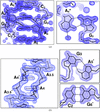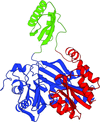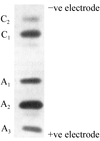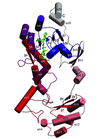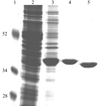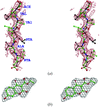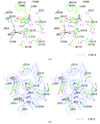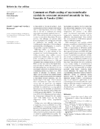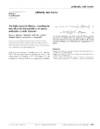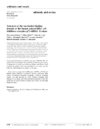issue contents
March 2004 issue

Cover illustration: Crystals from type II 3-dehydroquinate dehydratase (DHQase) from Actinobacillus pleuropneumoniae in a 0.7 mm capillary of the Granada Crystallization Box. The crystals were obtained in the International Space Station (ISS) during the Andromeda mission (p. 463).
research papers
The interaction between platelet glycoprotein (GP) Ibα and von Willebrand factor is essential for thrombus formation, leading to the arrest of bleeding. The crystal structure of the N-terminal domain of GP Ibα has been solved at 1.7 Å resolution.
PDB reference: monoclinic platelet glycoprotein Ibα N-terminal domain, 1qyy
Annealing experiments with flash-cooled protein crystals suggest that water is transported into or out of the crystal during the melting phase, depending on the ambient humidity. Measurements of the bulk density of cryosolvents suggest that during successful annealing the water transport modulates the thermal contraction of the cryosolvent in order to compensate for the thermal contraction of the protein crystal lattice.
The DNA fragments d(GCGAAGC) form a new type of bulge-in duplex with the G·A×A·G crossing in the central part, to which an addition of an A residue induces exchange of the partners of G·A pairs to form a base-intercalated duplex.
Likelihood-enhanced fast rotation functions have been developed and shown to be more sensitive to the correct orientation than the traditional fast rotation functions, especially when information from a partial solution can be exploited.
The first two crystal structures of binary complexes of full-length glycogen synthase kinase 3β with the ATP analogues hydrolysate ADP and AMPPNP are described. Although several other crystal structures of the enzyme have already been reported, none of them contain ATP analogues. The structures of these binary complexes reveal detailed features of nucleotide recognition by GSK3β and may have useful implications in the design of drug candidates against Alzheimer's disease.
The molecular replacement solution of a dimeric splicing endonuclease in pseudo-face-centered space group P21212 is reported.
PDB reference: truncated A. fulgidus endonuclease, 1r0v, r1r0vsf
High-resolution structures of urate oxidase–inhibitor complexes lead to a reformulation of the active-site topology.
The structure of the type II dehydroquinate dehydratase (DHQase) from A. pleuropneumoniae, the third enzyme of the shikimate pathway, has been determined.
PDB reference: type II 3-dehydroquinate dehydratase, 1uqr, r1uqrsf
The glycoprotein rhamnogalacturonan acetylesterase has been crystallized in two different polymorphic modifications: an orthorhombic crystal form which appeared at pH 5.0 and a trigonal form which was formed at pH 4.5. The differences in crystal packing can be explained by the pH-dependent variation in the protonation state of glutamic acids on the protein surface.
PDB reference: rhamnogalacturonan acetylesterase, 1pp4, r1pp4sf
Complexes of two piperidine ligands provide the first non-peptide cyclophilin–inhibitor structures. Enzymatic solution studies show Ki values of greater than 20 mM.
The crystal structure of the biotin carboxylase subunit of pyruvate carboxylase from A. aeolicus (PC-β) was determined at 2.2 Å resolution. One PC-β molecule is contained in the asymmetric unit with space group P21212; electron density for domain B was clearly shown in the final model.
PDB reference: BC subunit of pyruvate carboxylase, 1ulz, r1ulzsf
The lobster crustacyanin C2 protein subunit structure is reported at 1.3 Å resolution. A search for chemical structure post-translational modifications was made using three B-factor plot evaluations, but none proved sensitive enough to explain the C2 protein chromatography signature differences from the homologous A1 or C1 protein subunits.
An index Ras is proposed based on analysis of the Bijvoet differences of acentric and centric reflections to better estimate the accuracy and strength of the anomalous scattering signal in data.
structural genomics papers
Crystal structures are reported for free and coenzyme A (CoA) bound forms of the YfdW protein from E. coli, a representative type III CoA transferase.
crystallization papers
Crystals of the Ca2+-discharged W92F mutant of obelin from Obelia longissima have been grown, representing the first crystallization of a photoprotein after the Ca2+-triggered bioluminescence and bound with product, coelenteramide.
The small form of glucose-inhibited division protein A from T. thermophilus HB8 has been crystallized and its diffraction data have been collected to 1.65 Å resolution. Crystals belong to the trigonal space group P3121 or P3221.
The acyl-homoserinelactone synthase LasI has been crystallized in space group F23, with unit-cell parameters a = b = c = 154.90 Å. Crystals were obtained using a β-turn engineering approach.
The crystallizations of three different forms of the dimeric outer 5S subunit of transcarboxylase differ in their requirement for the addition of lithium sulfate.
The E. coli yeiK gene product has been overexpressed in recombinant form and characterized as a pyrimidine nucleoside hydrolase. Crystals diffracting to 1.7 Å resolution are reported.
Recombinant class I D-tagatose-1,6-bisphosphate aldolase from S. pyogenes was expressed in E. coli, purified and crystallized. Crystals of both native and selenomethionine isoforms were obtained and are suitable for structural analysis.
Aes has been crystallized as an N-terminally His6-tagged protein both in the native form and with selenomethionine substitution.
A novel bifunctional enzyme, phosphoribosyl isomerase, involved in both the histidine- and tryptophan-biosynthesis pathways, has been crystallized. Crystals diffract to 2 Å resolution and are suitable for X-ray structure determination.
The unique clostridial endo-β-galactosidase (Endo-β-GalGnGa) capable of releasing the disaccharide GlcNAcβ1,4Gal from O-glycans expressed in the gastric gland mucous cell-type mucin has been crystallized.
Focal adhesion protein 52 (FAP52) is a multidomain adaptor protein composed of an N-terminal α-helical domain and C-terminal SH3 domain connected by a predicted unstructured region. FAP52 was crystallized in two crystal forms and initial phase information was obtained from xenon-pressurized crystals using diffraction data collected at two softer X-ray wavelengths.
Xylanase IV from T. reesei has been crystallized and X-ray diffraction data have been collected to 2.2 Å resolution.
The extracellular xylanase from Geobacillus stearothermophilus T-6 (XT6) has recently been crystallized in a new monoclinic crystal form. The new crystals diffract to better than 1.5 Å resolution and show significantly improved crystallographic properties as compared with the previous crystals of XT6 of the hexagonal form.
Crystallographic analysis of the first complex between a PAS domain and another protein.
Crystals of fructan exohydrolase IIa from C. intybus have been prepared and proved to be suitable for successful structural analysis.
Crystals of two complexes of an endoxylanase inhibitor from T. aestivum L. with a family 11 xylanase have been prepared. The crystals of the complex TAXI I–A. niger xylanase as well as the crystals of TAXI I in complex with B. subtilis xylanase proved to be suitable for successful structural analysis.
A novel integral membrane lipoprotein, Wza, from E. coli serotype O9a:K30 has been purified and crystallized.
Crystallization and preliminary crystallographic analysis of the Escherichia coli water channel AqpZ
AqpZ is a 24 kDa integral membrane protein that facilitates water movement across the plasma membrane of E. coli. The first crystallization and preliminary X-ray analysis of AqpZ are described in this study.
The 36 kDa C-terminal domain of ParC from B. stearothermophilus has been crystallized in the trigonal space group P31 (or P32), with unit-cell parameters a = b = 83.5, c = 45.1 Å. A complete native data set to 2.0 Å has been collected.
Human liver glyceraldehyde-3-phosphate dehydrogenase was purified and crystallized. Crystals belong to space group P21, with unit-cell parameters a = 63.23, b = 97.84, c = 84.23 Å, β = 104.1°, and show diffraction to 2.8 Å resolution.
Macrophage/microglia-specific calcium-binding protein Iba1s from human and mouse were overexpressed and crystallized. A preliminary X-ray crystallographic analysis of the crystals is reported.
Monoclinic isomaltodextranase crystals which diffract X-rays to 1.8 Å resolution on a rotating-anode generator were grown from PEG 6000 and ammonium sulfate.
A recombinant form of histidinol phosphate phosphatase from T. thermophilus HB8 has been expressed in E. coli, purified and crystallized in crystal forms I and II, belonging to space groups P21212 and C2221, respectively. Diffraction data were collected to 1.70 and 1.75 Å resolution for crystal forms I and II, respectively.
Inorganic pyrophosphatase from the hyperthermophile P. horikoshii has been crystallized by the hanging-drop vapour-diffusion method at pH 5.0 using polyethyleneglycol 4000 as the precipitant.
Growth of hemihedrally twinned crystals of the small GTP-binding protein Rab9, which is implicated in vesicular transport from endosomes to the trans-Golgi network, in complex with GDP is described.
The crystallization and preliminary X-ray analysis of the β-D-xylosidase from G. stearothermophilus T-6, a family 39 glycoside hydrolase, is described. Purified native and selenomethionine-containing enzymes were crystallized and belong to space group P212121. The crystal diffracted X-rays to a resolution of 2.1 Å.
A γ-type cyclodextrin glycosyltransferase that produces γ-cyclodextrin as the main product has been crystallized and analyzed by X-ray diffraction. Phasing was successfully carried out using the molecular-replacement method.
Native and selenomethionyl-labelled protein of the ssRNA-packaging ATPase from bacteriophage φ12 crystallizes in space groups I222 and P1. Data have been collected for both space groups, to 2.5 and 2.0 Å resolution, respectively.
NCAM Ig1-4, NCAM Ig1-5 and the whole extracellular part of L1 were crystallized. Preliminary data have been collected on NCAM Ig1-4 crystals belonging to space group P622 or P6322.
short communications
Hexagonal crystals of unliganded tethered HIV-1 protease combined with the soaking method for the preparation of crystalline complexes have been shown to be suitable for the rapid discovery of protease inhibitors as drugs against AIDS.
LySDB is a centralized web resource with a user-friendly search engine developed to study the properties of the lysozyme structures available in the literature.
A crystallization strategy termed `microseed matrix screening' is described where the optimal conditions for nucleation versus extended lattice growth are not compatible.
PDB reference: yCD crystal form I, 1ra0, r1ra0sf
Perdeuterated yeast inorganic pyrophosphatase has been produced and crystallized. Neutron diffraction data have been recorded and the structure has been determined by X-ray diffraction.
Broad-range buffer systems that consist of three component buffers can be substituted for a single buffer in crystallization trials, allowing pH and buffer type to be decoupled.
The complex of lipoxygenase-3 with 4-nitrocatechol indicates His518 withdrawal from the iron coordination sphere and flexibility of the geometrical features of this site.
PDB reference: lipoxygenase-3:4NC complex, 1no3, r1no3sf
letters to the editor
Free 

Comment on Yao et al. (2004), Acta Cryst. D60, 39–45.
addenda and errata
Free 

Free 

Free 

Free 



 journal menu
journal menu













